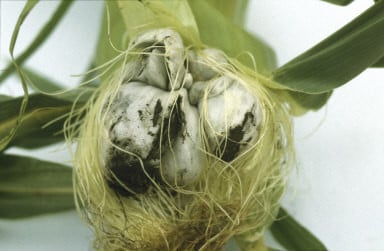
Quick facts
Common name - Smut
Scientific name - Various, often species of Entyloma, Urocystis or Ustilago
Plants affected - Various, including ornamental plants such as winter aconite and vegetables such as sweetcorn
Main symptoms - Vary according to the smut species, but include spots, blisters, distorted growth, production of dark spores
Caused by - Fungus
Timing - Spring/summer
What are smuts?
Smuts are fungal diseases that can affect leaves, stems, flowers and sometimes storage organs such as and corms. Some produce huge quantities of black spores which, when they are shed from the plant, resemble soot (or smut, hence the common name).
Smuts are relatively specialised pathogens with narrow host ranges. For example, the smut that affects sweetcorn is caused by a different species of fungus from the one attacking carnations.
Many grasses are also affected by smut diseases, although they are rarely a problem on the species and cultivars grown in the garden. However, on members of the grass family grown as valuable cereal crops, such as wheat and barley, smuts (or bunts, as some of them are called) can be a significant problem.
Symptoms
You may see the following symptoms:
On Allium species (including onions, leeks, chives & shallots), Anemone, Gladiolus, globe flower, onion, Ranunculus, Viola, winter aconite
- Smuts on these hosts tend to affect the leaves and/or the stems
- Dark streaks or blisters develop on the affected plant parts
- The blisters eventually rupture to release a powdery mass consisting of huge numbers of microscopic dark brown or black spores
- Growth may be stunted, and on Allium species affected leaves are often swollen and distorted
- Corms of Gladiolus can also be affected
On carnation and Scilla:
- These hosts are attacked by anther smuts, which affect the male reproductive parts of the flower
- Instead of producing pollen grains, the anthers are filled with dark smut spores
- The spores are released as the flowers open, spoiling their appearance
On sweetcorn:
- Affected plants are often stunted and distorted
- Some of the kernels on the cob (the number and position will vary) become greatly swollen and grey in colour
- These kernels burst to release huge numbers of black spores
- Swellings and blisters may also develop on the leaves, stems and inflorescences. Some of these will also rupture to release spores
On Calendula, Cosmos,Dahlia, Eschscholzia, forget-me-not and Gaillardia:
- Smuts on these hosts cause leaf spots, and do not release the dark spore masses seen with other smuts
- Older leaves are usually affected first
- Leaf spots can be circular or irregular in shape. Sometimes (e.g. on Dahlia) they are bordered by the leaf veins to give a more angular appearance
- White spore production may sometimes be seen on the surface of affected leaves
- The spots are often pale green or yellow when new, but gradually darken to light or dark brown. They may have a yellow margin. On forget-me-not they remain small and off-white in colour
- Severely affected leaves of Calendula, Cosmos, Dahlia, Eschscholzia and Gaillardia may turn brown and shrivel

Control
Non-chemical control
- In most cases affected plants should be destroyed, and the soil rested from that particular plant type for several years
- Dahlia tubers are not colonised by the smut fungus, and can be stored and re-used if all of the foliage is removed. They should be planted in a fresh site the following year
- Lightly-infected gladiolus corms can be saved by hot water treatment, although this is probably worthwhile only for particularly valuable stocks. Immerse the corms at 47°C (117°F) for 45 minutes
- Onion smut only infects plants through the first leaf produced. Plants raised in a disease-free can therefore be into contaminated soil without risk of infection
- If infection occurs in a greenhouse (e.g. on carnations), treat with a disinfectant before re-stocking with the same host
- Resistant cultivars are available for some hosts (e.g. sweetcorn). However, smuts often exist as a number of distinct ‘races’. As the cultivars may not be resistant to all of the races they cannot be relied upon to give complete control
Chemical control
There are no fungicides available for the control of smut diseases.
Biology
The smuts producing masses of dark spores on the hosts listed are mainly species of Urocystis and Ustilago. Those producing leaf spots without obvious spore masses are species of Entyloma (often referred to as white smuts). Entyloma smuts produce resilient resting spores that are embedded within the affected leaf tissue and released into the soil as the fallen leaves rot down.
Spores of all of the smut species can contaminate the soil for long periods of time (15-20 years in the case of onion smut). They eventually germinate to produce a second spore type that infects the plant. In some cases (e.g. Entyloma smuts) spores can also germinate in situ on the plant, and the disease may then spread rapidly during the growing season.
Some smuts are able to colonise the entire plant internally in what is known as a systemic infection (even though symptoms and spore production may be confined to isolated parts of the plant). Others remain localised in the parts of the plant where symptoms are produced.
In 2012, Entyloma smut of Eschscholzia californica (California poppy) was recorded by the RHS for the first time in the UK.









